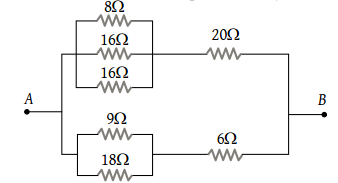A cell of negligible resistance and e.m.f. 2 volts is connected to a series combination of 2, 3, and 5 . The potential difference in volts between the terminals of 3 resistance will be :
1. 0.6 V
2. 2/3 V
3. 3 V
4. 6 V
Four wires of equal length and of resistances 10 ohms each are connected in the form of a square. The equivalent resistance between two opposite corners of the square is :
1. 10 ohm
2. 40 ohm
3. 20 ohm
4. 10/4 ohm
Two resistors are connected (a) in series (b) in parallel. The equivalent resistance in the two cases is 9 ohm and 2 ohms respectively. Then the resistances of the component resistors are :
1. 2 ohm and 7 ohm
2. 3 ohm and 6 ohm
3. 3 ohm and 9 ohm
4. 5 ohm and 4 ohm
Resistors of 1, 2, 3 ohm are connected in the form of a triangle. If a 1.5-volt cell of negligible internal resistance is connected across a 3-ohm resistor, the current flowing through this resistance will be :
1. 0.25 amp
2. 0.5 amp
3. 1.0 amp
4. 1.5 amp
Resistances of 6 ohm each are connected in the manner shown in adjoining figure. With the current 0.5 ampere as shown in figure, the potential difference is
1. 3.6 V
2. 6.0 V
3. 3.0 V
4. 7.2 V
The equivalent resistance of the arrangement of resistances shown in adjoining figure between the points A and B is
1. 6 ohm
2. 8 ohm
3. 16 ohm
4. 24 ohm
In the network of resistors shown in the adjoining figure, the equivalent resistance between A and B is
1. 54 ohm
2. 18 ohm
3. 36 ohm
4. 9 ohm
A wire is broken in four equal parts. A packet is formed by keeping the four wires together. The resistance of the packet in comparison to the resistance of the wire will be
1. Equal
2. One fourth
3. One eight
4.
In the given figure, when key K is opened, the reading of the ammeter A will be
1. 50 A
2. 2 A
3. 0.5 A
4.
If a resistance R2 is connected in parallel with the resistance R in the circuit shown, then possible value of current through R and the possible value of R2 will be
1.
2.
3.
4.











